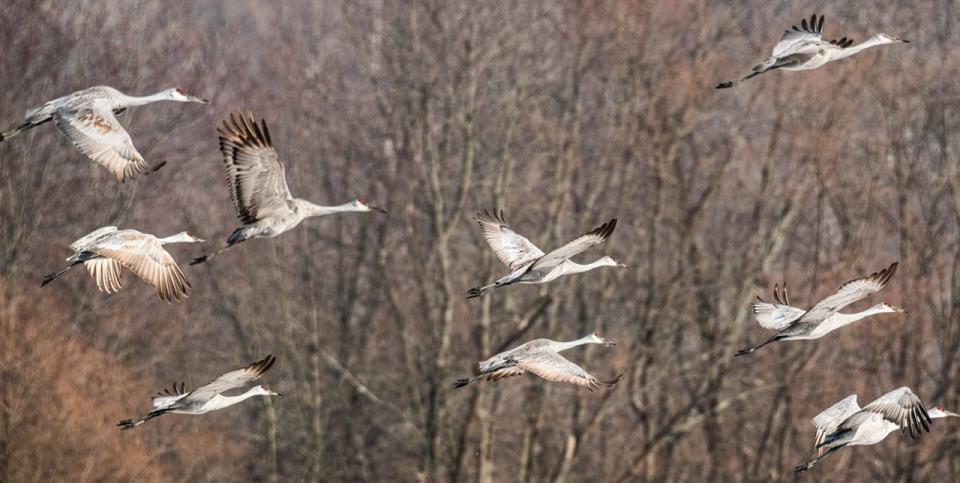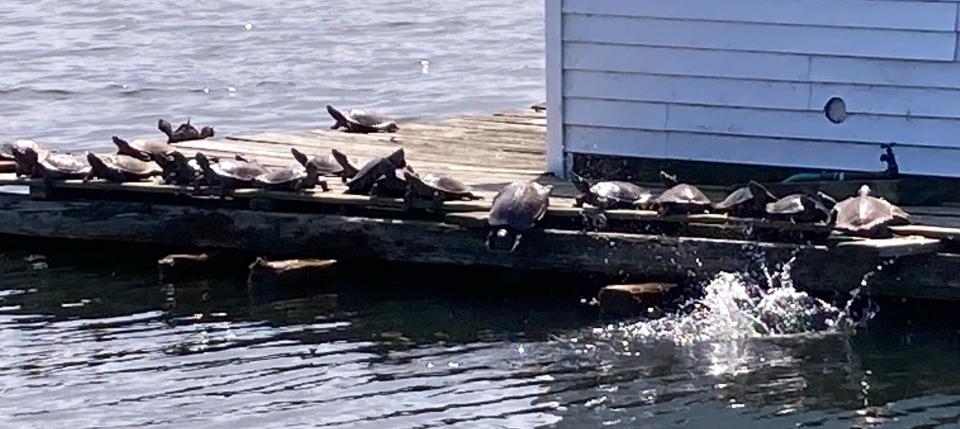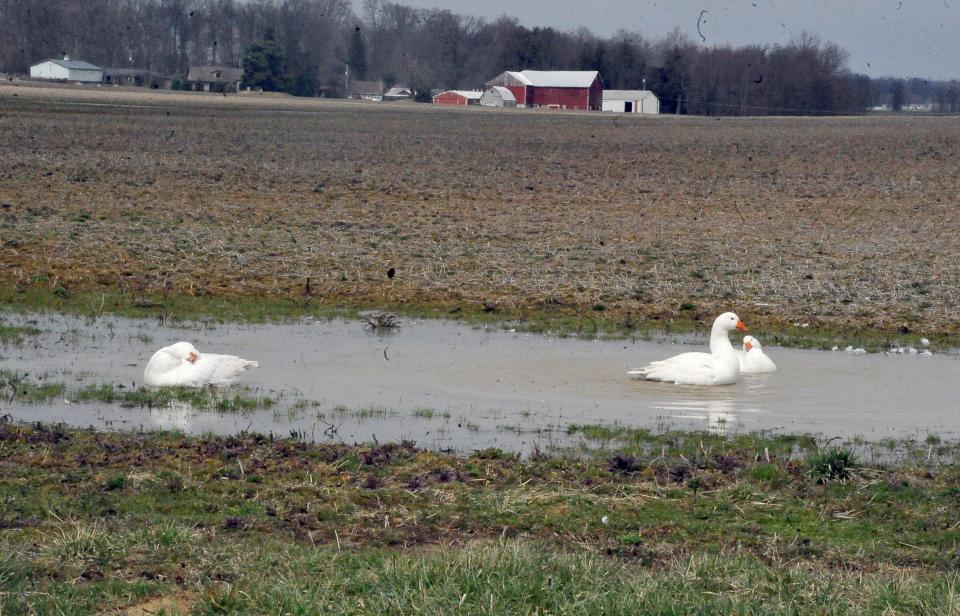Ever wonder why gaggle of geese, Parliament of owls, murder of crows came to be?

A month ago, while vacationing in California, I came across a kiosk while on a wildlife walk at Bolsa Chica Ecological Preserve informing visitors about the Anna’s Hummingbird. Along with other information, it mentioned that a group of hummingbirds can be called anyone of five words.
And I’m not talking about common, everyday wildlife group names like flock, pod, herd or colony. No, hummingbirds groups go by “a bouquet, a glittering, a hover, a shimmer or a tune.” How cool is that?
Mushroom season: What are Mother Nature's signs that it's morel season?
That bit of information piqued my interest. I’ve always tried to be correct when writing outdoor stories, not to get my “herds” messed up with “flocks,” and “coveys,” let alone “clouds.”
You see, when it comes to birds, not every group is automatically considered a flock – that depends on both numbers and composition of the group. When it comes to mammals, not every species is a herd. In fact, in the cat family, the lion, tiger and leopard all have different words for their groups – a pride of lions, a leap of leopards and an ambush of tigers.
Battling the waters for fish: Battling the weather for a tug on the line at Silver Creek, Lake Milton
Naming convention began in 1486 with 'The Book of Saint Albans'
It seems a lot of the “group” names came from a 500-year-old book published in 1486 on the etiquette of hunting – both a sport at the time, but also a necessity as a food source. “The Book of Saint Albans” is one of the first places a “gaggle of geese,” “herd of deer,” “flock of sheep” and a “crash of rhinos” was ever in print.
A lot of the group names come from either the sound the species makes (gaggle of geese, scold of jays) or how they look (“stand” of flamingos).
For instance, a “Parliament” of owls refers to their perceived knowledge and wisdom. Owl groups also have been called a “Congress” or “stare,” but the 1950s children’s book “The Chronicles of Narnia” (which later became a movie), cemented Parliament as the go-to word for a group of owls.
Of course, one of my favorite group names is “a murder of crows,” which, too, dates back some 500 years. However, from what I can gather, rarely has anyone who studies crows, or owls, or a lot of birds and animals, for that matter, uses the archaic names that ancient authors came up with.
Still, it’s fun to learn the collective noun for animal groups, often quirky or peculiar, but also spot on at times, and that knowledge may win you a trivia game in the future.


Giraffes 'tower,' hippos 'bloat' and crocodiles 'bask'
While I doubt I will ever go on an African safari, I would love to see a “tower” of giraffes, a “bloat” of hippos, a “memory” of elephants or a “bask” of crocodiles (conversely, it’s called a “congregation” of alligators).
Right here in our own back yard we might run into a “skulk” of foxes or a “gaze” or “nursery” of racoons. Coming across a “knot” of frogs wouldn’t be as bad as stepping on a “knot,” of snakes, which also are called a “bed” or “den” or “pit” of snakes.
On the other end of the spectrum, it would be cute to see a “scurry” or “dray” of squirrels; a “raft” of otters or a “bale” of turtles.
Most everyone knows whales in a group are called a “pod,” monkeys a “troop” and wolves a “pack,” but did you know a bunch of parrots is appropriately called a “pandemonium,” and multiple peacocks an “ostentation?” One I didn’t know, and should have, was that a group of bears is called a “sleuth” or “sloth.”
Have more than three cats? That's called a 'clowder'
Some other off-the-wall group names include “smack” of jellyfish; “clowder” for three or more house cats; “gulp” for a flock of cormorants; and what fisherman wouldn’t want to come across a “hover” of trout. Bees can be a “hive,” “nest,” “rabble” or “stand.” In some parts of the world, a group of bees is called a “bike” of bees because bike is an old English word that means colony, nest or swarm.
Birds group names are maybe the most confusing as some depend on where and what the bird is doing. Geese found on land would be referred to as a “gaggle,” whereas a group of geese seen flying is often referred to as a “skein” or “wedge” depending on the formation.
A group of penguins in the water is called a “raft,” a group of penguins on land is called a "waddle,” and they live in rookeries, colonies or huddles.
Herons also live in rookeries, but groups of them are called a “siege,” “sedge” or “scattering.” Gulls can be called a “gullery,” “flotilla,” “squabble” or “colony.”
Birds of prey like hawks and falcons in a group are known as a “cast,” “cauldron” or “kettle.”

Three titles for swans: 'Wedge' in flight, 'bevy' in water, 'bank' on ground
Swans in flight can be called a “wedge,” on the water a “bevy,” but when they’re on the ground they are referred to as a “bank” of swans. Similarly, vulture group names differ depending on the activity. A group of vultures is called a “committee,” or “volt.” In flight, a flock of vultures is a “kettle,” and when the birds are feeding together at a carcass, the group is called a “wake.”
Sandhill cranes, which are found in abundance now in the Killbuck Marsh Wildlife Area, can be a “sedge” or “siege,” but also have some cool group names like a “construction” of cranes, a “dance” of cranes and a “swoop” of cranes.
A “pod” of whales can also be called a “gam,” “herd" and “plump,” but a group of the narwhal whales is called a “blessing.”
And just for fun, how about a “harem” of seals, a “mob” of kangaroos, a “pod” of pelicans, a “shiver” of sharks, a “scourge” of mosquitoes, a “dazzle” of zebras, a “band” of gorillas, a “colony” of bats, a “consortium” of octopus and you’ve got to love a “prickle” of porcupines.
The poor worm, though, is just a “bunch.”
Outdoor correspondent Art Holden can be reached at letsplabal@yahoo.com.
This article originally appeared on The Daily Record: Wise old owl is a Parliament for a reason; frogs and snakes knot

